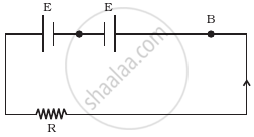Advertisements
Advertisements
प्रश्न

Vinita and Ahmed demonstrated a circuit that operates the two headlights and the two sidelights of a car, in their school exhibition. Based on their demonstrated circuit, answer the following questions.
- State what happens when switch A is connected to:
a) Position 2
b) Position 3 - Find the potential difference across each lamp when lit.
- Calculate the current.
a) in each 12 Ω lamp when lit.
b) In each 4 Ω lamp when lit.
OR - Show, with calculations, which type of lamp, 4.0 Ω or 12 Ω, has the higher power.
उत्तर
- (a) 12 Ω lamps (only) on.
(b) 4 Ω lamps (only) on. - 12 V for both sets of lamps and all of them are in parallel.
- a) 12 Ω lamps are on when the wire is connected to position 2.
The voltage across both 12 Ω lamps = 12 V.
V = IR (Ohm’s law)
`"I" = "V"/"R" = 12/12 = 1 "A"`
b) 4 Ω lamps are on when the wire is connected to position 3.
The voltage across both 4 Ω lamps = 12 V.
V = IR (Ohm’s law)
`"I" = "V"/"R" = 12/4 = 3 "A"`
OR - `"P" = "V"^2/"R"`
All lamps are in parallel and hence the same V for all lamps.
For 4 Ω lamps → P = `(12 xx 12)/4` = 36 W
For 12 Ω lamps → P = `(12 xx 12)/12` = 12 W
Hence 4 Ω lamps will have higher power.
APPEARS IN
संबंधित प्रश्न
Find the resistance of a conductor if 0.24 A current is passing through it and a potential difference of 24 V is applied across it.
Name the unit of electrical resistance and give its symbol.
How would you connect two resistors in series? Draw a diagram. Calculate the total equivalent resistance.
Ohm’s law states the relationship between power and voltage.
State macroscopic form of Ohm’s law.
Define temperature coefficient of resistance.
The temperature of a conductor is increased. The graph best showing the variation of its resistance is:
Two cells of same emf E but internal resistance r1 and r2 are connected in series to an external resistor R (Figure). What should be the value of R so that the potential difference across the terminals of the first cell becomes zero.
The voltage - current readings of a certain material are shown in the table given below:
| Voltage (V) | 10 V | 20 V | 30 V |
| Current (I) | 2 A | 3 A | 4 A |
Study the table.
- State whether the conductor used is ohmic or non-ohmic.
- Justify your answer.
- State Ohm's law.
